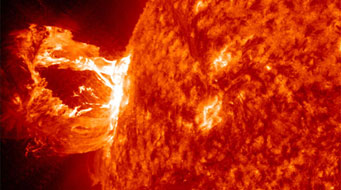The burst of plasma belched out in this coronal mass ejection on April 16th isn't headed toward us, but NASA's Goddard Space Weather Lab predicts that it will hit the Stereo B spacecraft and possibly the rover Curiosity en route to Mars. More eruptions could be in store: the same active region erupted on Sunday, and then again on Monday, and solar rotation continues to carry the region around the face of the Sun.

A moderate, but visually spectacular solar flare erupts at about 17:45 Universal Time on April 16, 2012.
Credit: NASA/GSFC/SDO
This solar flare was classified as an M1.7, so it's right in the middle of the scale used for eruptions like these, which classifies flares as A, B, C, M, or X, with X-class flares being the most powerful. Even if it were directed at Earth, an M1.7 solar flare probably wouldn't have affected us much: no strong aurorae and no satellite disruptions.
Still, the eruption, cast out over the Sun's eastern limb, was a beautiful view, and not just for spacecraft. Amateur astronomers with some very good timing managed to catch the event as it happened.
Future coronal mass ejections are very difficult to predict — space weather forecasting is at least 50 years behind Earth weather forecasting. Still, I wouldn't be surprised if this active region produced another flare sometime soon.
 2
2
Comments
al schober
April 20, 2012 at 6:21 pm
Thanks so much for the beautiful video of the solar flare. The colore are unreal an just show how much our beautiful universe can be an inspiration to all mankind to explore.
You must be logged in to post a comment.
Alison
April 20, 2012 at 10:39 pm
Nitpicking... Affect is a verb; Effect is a noun...
Cool video! 🙂
You must be logged in to post a comment.
You must be logged in to post a comment.